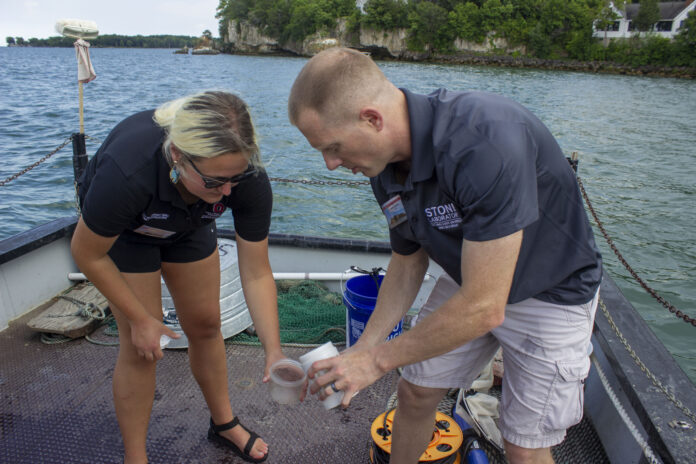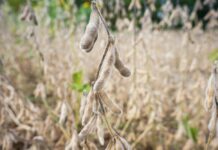
SOUTH BASS ISLAND, Ohio — In the calm, shallow harbor off the shores of Put-In-Bay, Justin Chaffin, research coordinator for the Stone Laboratory, tossed a small disk attached to a rope over the side of a research vessel. He was using a Secchi disk, a more than 150-year-old technology, to measure the clarity of the water. The disk sank about 10 feet, almost reaching the bottom before disappearing from view.
“If the water’s clear, this goes down deeper and deeper and deeper. When it’s muddy or green, it disappears quickly,” Chaffin explained. “The water right now is really clear for Lake Erie.” He said the phenomenon is known as the “clear water phase,” a period when the lake becomes more transparent due to zooplankton feeding on algae.
But that visibility may not last. In just a few weeks, the lake could be coated with a green scum and the microscopic makings of a harmful algal bloom, overladen with cyanobacteria, which can be toxic to both people and animals.
Mild to moderate
At a June 26 press conference held at Ohio State University’s Stone Laboratory on Gibraltar Island in Put-In-Bay, scientists predicted this year’s harmful algal bloom season would likely be mild to moderate, similar to recent years. Rick Stumpf, an oceanographer with the National Oceanic and Atmospheric Administration, said this year’s forecast puts it “right on the border between a mild and a moderate bloom,” estimating its potential severity at a three on a scale of 10. That’s a bit lower than last year’s, which measured as a four.
To help track the blooms, Stumpf said satellite data has been an invaluable tool, calling it a “virtual time machine” that lets scientists look back at bloom activity as far as February 2002, the year they first began to appear annually. But today’s blooms are harder to contain, despite past successes.
“In the ‘70s and early ‘80s when there were extensive blooms and people declared Lake Erie dead, it recovered significantly because of the Clean Water Act,” he said. “But now we’ve seen the reappearance of this.”
Harmful algal blooms have become a recurring issue over the past 25 years, largely tied to agricultural runoff. Stumpf explained that phosphorus flowing into the lake from the Maumee River in spring is a key driver of bloom severity. But nutrient levels aren’t the only factor at play. While lake temperatures were cooler than usual through mid-June, they’ve started to rise quickly, about one degree Fahrenheit per day since June 20.
That warming trend suggests the bloom will likely become visible in early July, peaking in August and staying within Lake Erie’s Western Basin.

Because blooms are shaped by wind and currents, their movement across the lake is hard to predict. That’s an area researchers are working to improve. Understanding these wind patterns is crucial because they influence where the blooms travel and which areas are most affected each season.
When asked by Farm and Dairy whether it’s possible to predict where the bloom will drift once it forms, Stumpf acknowledged the complexity of the task.
“We can say the blooms start in the Maumee Bay, mouth of the Maumee River area. After that, it’s very dependent on prevailing winds,” he said. Winds from the southwest usually steer it toward Canada. Northwest winds push it toward Ohio’s shoreline, while easterly winds often send it back in the direction of Michigan.
Despite some success in lowering phosphorus levels, Stumpf cautioned against complacency, warning that a wet spring could still trigger a more severe bloom. He emphasized that it’s too soon to celebrate smaller peak blooms as a lasting win.
“We’re (making) the right progress on reducing the phosphorus, but we can’t control the rain and the runoff,” he said.
Small volume, big footprint
Nate Manning, interim director of the National Center for Water Quality Research at Heidelberg University, said the Maumee River continues to play an outsized role in fueling Lake Erie’s algal blooms.
“The Maumee only contributes about 5% of the water that enters Lake Erie. (But) it’s contributing about half of the nutrient load and sediment that gets into the lake,” Manning said.
Manning’s team leads the Heidelberg Tributary Loading Program, which has been tracking water quality in the Maumee River and its tributaries for nearly 50 years. Using automated samplers maintained by the U.S. Geological Survey, they collect water samples three times a day, rain or shine.
That high-frequency monitoring gives researchers an almost real-time view of how nutrient levels in the water are changing. One of the key indicators they watch is total bioavailable phosphorus, the type of phosphorus that directly feeds algae growth. It includes both dissolved phosphorus, which passes through water filters, and a small but highly active portion attached to particles. As of June 16, about 227 metric tons had already flowed into the lake’s Western Basin. That total is expected to rise to between 235 and 273 metric tons by early July, coming close to the regional target of 240 metric tons set by the U.S. and Canada.
Other results this year are drawing increased attention. Manning said particulate phosphorus, the kind that gets caught in filters during water testing, was unusually high, reaching about 1,100 metric tons by mid-June. That’s well above the expected level of 847 metric tons for current river flow, and far over the long-term goal of 674 metric tons. He pointed to intense storms in April as the likely cause. Because the rain came before crops were planted, there was little vegetation to hold soil in place. That allowed more sediment — and the phosphorus attached to it — to wash into the river. Although only about 8% of particulate phosphorus typically contributes to algae growth, large surges like this can still raise the risk of harmful algal blooms.
On the other hand, dissolved reactive phosphorus (DRP) — the form most likely to trigger harmful algal blooms — measured 148 metric tons as of June 16, below both the seasonal target of 186 and the expected 205 metric tons.
“This is the first time in the last five to 10 years that we’ve been below target on DRP,” Manning said. “We’re seeing levels sort of pre-2000 with DRP.”
Despite above-average rainfall this season, both DRP and TBP are lower than expected given the water flow.
“It has rained more this year than it did last year. But our loads and our concentrations are lower than what we saw last year,” he added.
Monitoring efforts
After the press conference, researchers brought guests out onto Lake Erie to showcase some of the tools they use to monitor harmful algal blooms.
“You see the buoy behind us?” Chaffin said, pointing to a floating sensor. It’s equipped with sensors that measure water temperature, oxygen levels, how salty the water is, and the presence of algae. About 15 of these buoys are spread across the lake, sending real-time data to a public website.
Chaffin pulled up a water sample, tinted gold by cold-loving diatoms, beneficial algae that fade as temperatures rise. Their absence gives way to toxin-producing cyanobacteria, which play a neat but devious trick of outcompeting other algae species.
“Cyanobacteria will increase the pH of the water, which the diatoms can’t tolerate, either,” he said.
Next, he demonstrated a plankton net and an algae sampler that collects water down to two meters, helping scientists study blooms even in rougher conditions. While phosphorus remains the main culprit behind blooms, nitrogen is gaining attention.
“All the old textbooks say it’s the phosphorus only,” Chaffin told Farm and Dairy. “We know phosphorus is bad. Phosphorus with nitrogen can make (blooms) worse.”
He explained that by late summer, nitrogen levels in the lake often drop, especially near the shore. That’s a problem because most algae need nitrogen to grow. Microcystis, which blooms farther out in the lake, might struggle more in low-nitrogen conditions. But a type of cyanobacteria called Planktothrix, which usually blooms near the shoreline, has a survival advantage: It can find and use leftover nitrogen sources that other organisms can’t. This means it can keep growing even when nitrogen is scarce, making it harder for scientists to predict and manage harmful algal blooms.
Budget cuts
The research and monitoring efforts on Lake Erie together offer a detailed sketch of how blooms form and spread, but science alone isn’t enough to put a stop to them. Except now, Ohio has fewer resources to combat the problem.
In late June, state lawmakers finalized Ohio’s two-year budget, and with it came deep cuts to H2Ohio, the state’s flagship water quality initiative. H2Ohio will lose more than $50 million in funding, or nearly 40% of its budget, this year.
The Ohio Environmental Protection Agency and the Ohio Department of Natural Resources were hit hardest, with their portions of the program slashed by 73% and 55%, respectively. The Ohio Department of Agriculture saw a smaller but still significant 12% cut.
The funding reduction has sparked concern among environmental advocates, who warn of serious consequences for Ohio’s water resources.
“Water quality is a staple of life for our drinking water, our recreation, and many Ohio businesses. For six years, the H2Ohio program has protected waterways to safeguard Ohioans. The funding cuts in HB 96 deliver a devastating blow to Ohio’s communities, threatening the very waterways they rely on for life, livelihood, and future prosperity,” said Pete Bucher, executive director of the Ohio Environmental Council Action Fund, in a June 25 press release.
Gov. Mike DeWine signed the final budget on June 30, but it remains to be seen whether the investment will be enough to turn the tide on Ohio’s algal blooms.









